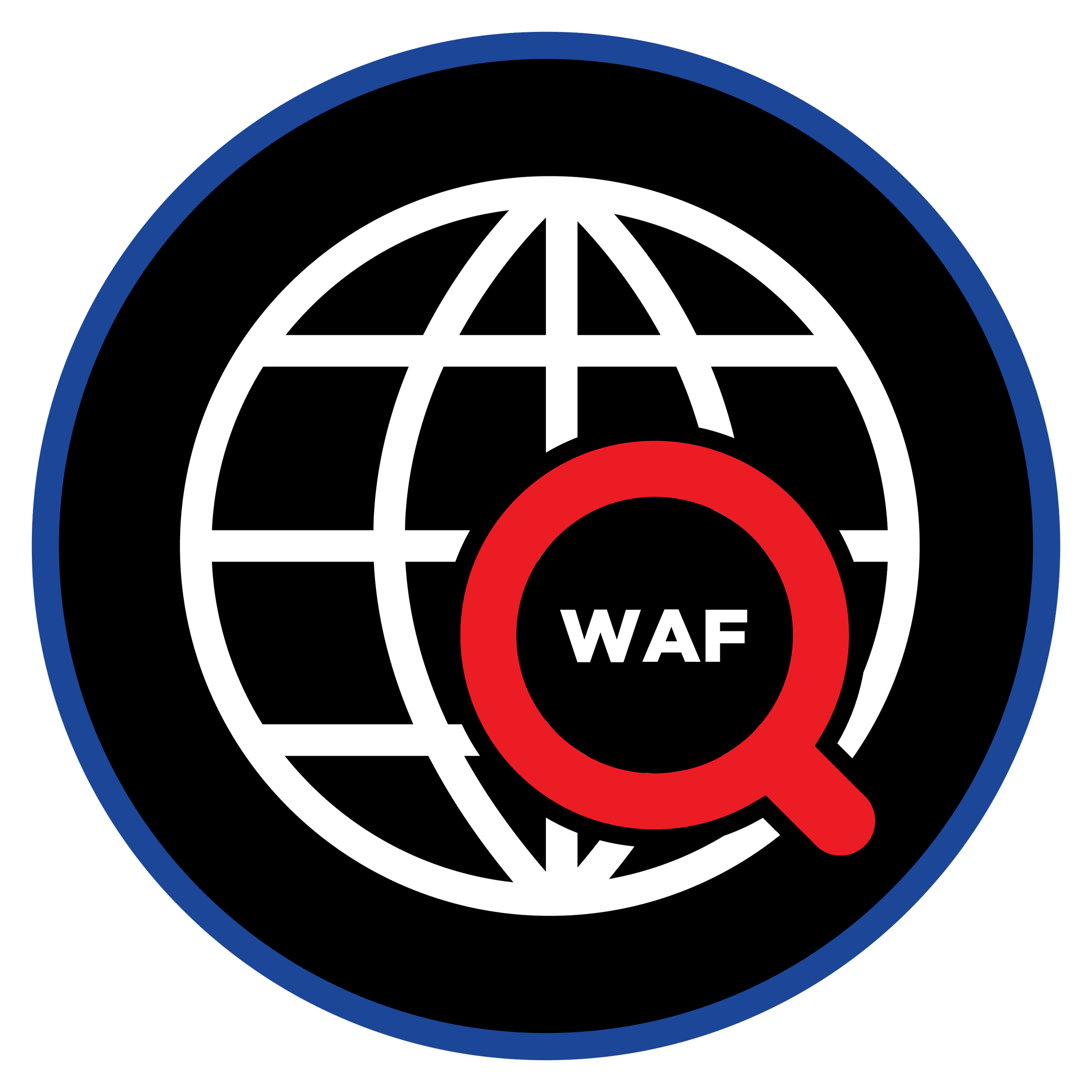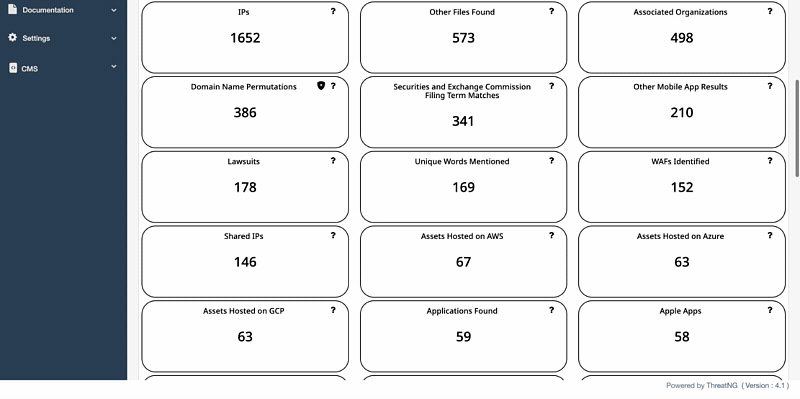
External Web Application Firewall (WAF) Identification
Beyond Internal Telemetry: Use the External Adversary View to Guarantee WAF Consistency
Your enterprise has invested heavily in Web Application Firewalls (WAFs) to secure its perimeter. But the complex reality of decentralized cloud environments and organizational fragmentation means your security is built on a dangerous false sense of security. External attack surface data confirms that over half of internet-exposed cloud assets—including pages collecting sensitive PII—remain critically unprotected. ThreatNG WAF Discovery and Identification cuts through this complexity. Just by providing your organization’s domain and name, we initiate the External Truth Layer you need, performing purely unauthenticated validation to deliver decisive security insight and ensure every single subdomain is covered from the adversary’s view.
Eliminate Blind Spots: Gain Complete Visibility with Domain Intelligence
Comprehensive WAF Detection
Identify various WAF vendors and products, including commercial and open-source solutions.
Actionable Intelligence
Leverage WAF information to tailor your penetration testing strategies and security assessments.
Integration with Domain Intelligence
Seamlessly access WAF data alongside other domain intelligence insights for a holistic view of your targets.

ThreatNG WAF Identification: Your Key to Unlocking a Comprehensive View of Your Attack Surface
Understanding your external attack surface is paramount in the ever-evolving landscape of cybersecurity threats. ThreatNG's WAF Identification capability is a crucial component of its comprehensive Domain Intelligence module, empowering organizations with actionable insights into their web application security posture.
How WAF Identification Fits into ThreatNG:
ThreatNG's holistic approach to external attack surface management (EASM), digital risk protection (DRP), and Security Ratings goes beyond mere vulnerability scanning. By seamlessly integrating WAF identification into its robust Domain Intelligence framework, ThreatNG enables organizations to:
Uncover Hidden Risks
Detect and identify the presence of web application firewalls (WAFs) protecting target websites.
Gain deep insights into potential vulnerabilities.
Understand the level of protection the WAF offers and identify potential bypass techniques.
Enhance Security Assessments
Integrate WAF information with other Domain Intelligence findings to comprehensively view your attack surface.
Tailor penetration testing strategies and security assessments based on the identified WAF and its configuration.
Proactively address weaknesses in WAF protection to strengthen your overall security posture.
Optimize Security Investments
Make informed decisions about WAF upgrades, replacements, or additional security measures based on ThreatNG's findings.
Justify security investments by quantifying the risks associated with inadequate WAF protection.
Demonstrate the value of your security program by showcasing a comprehensive understanding of your external attack surface.
WAF Identification Strengthens Web Application Security
ThreatNG's Web Application Firewall (WAF) Identification is crucial in safeguarding against web application vulnerabilities. By identifying and assessing WAF implementations, ThreatNG ensures that these protective measures are effectively deployed and configured to mitigate risks like Application Layer DoS attacks, SQL injections, cookie poisoning, XSS, and file inclusions. This proactive approach strengthens an organization's security posture by validating the presence and effectiveness of WAFs, a critical line of defense against web attacks.

From Compliance Anxiety to GRC Assurance: Eliminate the PII Exposure Blind Spot
End the crippling Compliance Anxiety that comes with knowing over 63% of your PII-collecting non-cloud assets might be undefended. ThreatNG serves as your continuous GRC Control Validation Layer, mapping WAF coverage status directly to critical regulatory frameworks, including PCI DSS, HIPAA, and GDPR. We proactively identify the highest-risk assets that lack this fundamental protection, providing the hard, external evidence needed to build unshakeable confidence and justify your security investment to the board with measurable, validated results.
Replace Multi-Day Fire Drills with Decisive, Minute-by-Minute Insight
The enemy is organizational chaos. Stop wasting valuable analyst time on stressful, multi-day manual fire drills to confirm a WAF is active on an unknown asset. ThreatNG instantly performs External WAF Discovery, identifying the presence of WAFs and the specific vendor (Cloudflare, Imperva, AWS WAF, etc.) down to the subdomain level. This automated, precise validation turns chaotic manual searching into decisive security insight, instantly freeing operational resources for reallocation to high-impact threat hunting.

Gain Total Control: The Unauthenticated External View that Eliminates Inconsistency
You are likely managing a fragmented stack of a dozen or more WAF products. Inconsistency is what the attacker exploits. Our solution is powered by the External Adversary View, leveraging purely unauthenticated discovery to ensure your entire external attack surface—including unknown or "Shadow IT" assets—is validated. By detecting WAFs as Positive Security Indicators, we give you the control to see the perimeter exactly as the threat actor does, eliminating internal organizational blind spots for good.
Support List
Web Application Firewall (WAF) Platforms
Alert Logic (HelpSystems)
Anquanbao (Qihoo 360)
Approach
Astra Security
Barracuda Networks
BinarySec
BitNinja
BlockDos
Chaitin Tech
Cloudbric (Penta Security Systems)
Cloudflare
Comodo (now Sectigo)
CrawlProtect (DenyAll)
DenyAll
Distil Networks (Imperva)
F5 Networks
Fortinet
GreyWizard
HyperGuard (Art of Defense)
IBM
Imperva
Imunify360 (CloudLinux)
Indusface
Janusec
Malcare
NAXSI Project
Netcontinuum (Barracuda Networks)
NewDefend
Nexusguard
NinjaFirewall
NSFOCUS
OnMessage
Palo Alto Networks
Penta Security Systems
PerimeterX
pkSec
Positive Technologies
Profense (ArmorLogic)
Reblaze
Sabre
Safe3 Web Firewall
SafeDog
SecKing (NSFOCUS)
SecuPress
SecureIIS
SEnginx (Neusoft)
Shadow Daemon
Shield Security
SiteLock
SonicWall
Sophos
Sucuri (GoDaddy)
Wallarm
WatchGuard
WebARX Security
WebKnight (AQTRONIX)
WebRay
Wordfence
XLabs Security
Xuanwudun (NSFOCUS)
Yundun (Alibaba Cloud)
ZenEdge (Oracle WAF)
ZScaler
Cloud Providers / Content Delivery Networks (CDNs)
Alibaba Cloud Computing
Amazon Web Services (AWS)
ArvanCloud
Azion
Baidu
Bekchy
BelugaCDN
ChinaCache
Cloudfront (AWS)
Huawei Cloud
KeyCDN
PowerCDN
Qiniu
Tencent Cloud
UCloud
West263
Web Hosting / Website Builder Platforms
GoDaddy
Squarespace
Synology
WAFs from Other Vendors
Bluedon
Eisoo
OpenResty Inc.
TransIP
Viettel
YxLink
Other WAF Providers
Bluedon
EisooaeSecure
AireeCDN
AnYu
ASPA
Barikode
DynamicWeb
KnownSec
Mission Control (Sophos)
Nemesida
NullDDoS
RSFirewall
ServerDefender VPS (SiteLock)
SiteGround
URLMaster
VirusDie
WebLand
WebTotem
Yunaq
Yunsuo
Frequently Asked Questions (FAQ): ThreatNG WAF Discovery and Identification
This FAQ is designed to educate CISOs and VPs of Application Security on the critical need for external WAF coverage validation and how the ThreatNG capability provides indispensable assurance and control.
Why is WAF Coverage a Critical Blind Spot for My Enterprise?
-
The coverage gap is not typically a budget issue; it is a visibility and organizational inconsistency issue. External attack surface analysis confirms that large enterprises, which often manage an average of 12 different WAF products , fail to deploy them consistently across their entire perimeter. Our research found that over half (52.3%) of internet-exposed cloud assets and nearly two-thirds (66.4%) of off-cloud assets lack WAF protection. This gap is often caused by fragmented deployments, M&A activity, or decentralized "Shadow IT". ThreatNG fills this gap by acting as a continuous, objective validation layer, ensuring that your existing investment is actually protecting all exposed web applications.
-
Unprotected assets are exposed to fundamental and common web attacks, such as SQL injection and credential stuffing, which WAFs are designed to prevent. When these uncovered assets also collect Personally Identifiable Information (PII)—like login or checkout portals—the financial and regulatory risk skyrockets. Our data indicates that 63.4% of off-cloud PII-collecting assets are unprotected. This exposure represents a direct, critical GRC failure that can lead to catastrophic fines and an average breach cost approaching $5 million.
How Does ThreatNG Validate WAF Deployment and Provide Assurance?
-
Internal scanners often only confirm that a WAF configuration is present on a server. ThreatNG performs purely external unauthenticated discovery. This means it scans the asset from the perspective of an attacker, providing objective evidence of the WAF's active presence and effectiveness. This "External Adversary View" is the only way to confirm if a WAF is protecting the web application as intended on the public internet.
-
ThreatNG can discover and pinpoint the WAF presence down to the specific subdomain level. Crucially, it also identifies the specific WAF vendor. The solution maintains an extensive vendor list that includes dedicated WAF Platforms, Cloud Providers, Content Delivery Networks (CDNs), and Web Hosting/Website Builder platforms, covering major products like Cloudflare, Imperva, Fortinet, and AWS WAF.
-
ThreatNG’s "Positive Security Indicators" identify and highlight an organization's security strengths, moving beyond solely focusing on vulnerabilities. WAF Discovery and Identification is classified as a Positive Security Indicator because it detects the presence of a beneficial security control. It validates these measures from the external attacker's viewpoint, providing objective proof of their effectiveness and offering a more balanced view of your security posture.
Business Impact and Operational Efficiency
-
The capability provides a Continuous Control Assurance Layer by explicitly validating whether this fundamental control is active on all exposed assets. Our External GRC Assessment capability maps these findings directly to critical frameworks like PCI DSS, HIPAA, and GDPR. By proactively identifying and addressing these external security and compliance gaps, the CISO gains the objective evidence required to strengthen their overall GRC standing and report definitive security posture to the board.
-
Absolutely. ThreatNG eliminates chaotic and stressful "multi-day manual fire drills" that security analysts typically undergo when attempting to validate if basic security controls are active on new or unknown assets. By automating the WAF coverage status and vendor identification process and transforming chaotic manual searching into "decisive security insight" , your team recovers valuable time that can be reallocated to higher-impact threat hunting and remediation.













